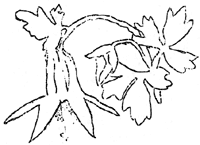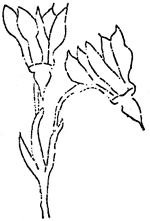The Location of Crater Lake National Park
By Earl U. Homuth, Senior Park Naturalist
When William G. Steel (Father of Crater Lake National Park) first came to the lake in 1885 he made the decision to do all in his power to have the lake preserved as a national park, a purpose to which he devoted the next seventeen years of his life.
Upon his return to Portland he immediately petitioned President Cleveland to set aside ten townships from settlement. Since no survey of this portion of Oregon had been made, Mr. Steel guessed as to the area which would include the lake and then a portion of the surrounding territory. His petition was acted upon by presidential proclamation the area designated as Mr. Steel was reserved.
In 1886, again upon petition of Mr. Steel the Geological Survey sent a field party, under the direction of Capt. Dutton, to make a survey of the region and soundings of the lake. Mr. Mark Kerr, for whom Kerr Notch is named, was chief topographer of the party.
One evening after considerable progress had been made in the preparation of the map, Mr. Kerr called Mr. Steel to his tent. He had the unfinished map before him. He casually asked Mr. Steel “How did you decide what area was to be set aside for your park?” “I had to guess at it”, Steel answered. “We had not authentic maps.” “Well”, Kerr answered laughingly. “Do you want it this way?” and he showed Steel where the eastern boundary of the proposed park cut across what is now Dutton Cliff to near Cleatwood Cove, excluding the east one third of the lake.
Mr. Steel was considerably surprised and somewhat disturbed by this revelation. But Mr. Kerr dispelled his worries by assuring him that he would fix the boundaries himself.
The line was drawn to include Scott Peak on the east, the many cones and craters, the interesting canyons cut in tuff south of the lake and the Pumice Desert on the north and the slope of Mount Mazama to the west. The total area is 249 square miles.
 |
Flowers, Where the Scene-shifter – Nature – Is Always Busy
By Lincoln Constance
The casual visitor to Crater Lake is quite apt to be disappointed when he fails to encounter the profusion of flowers which greet him at Rainier or Yosemite. The light soil of the windswept Rim has not yet put forth its full burden of vegetation, but even the intermittently stormy weather has not prevented the alpine meadows near by from producing a rainbow of color. This floral display is best exhibited in the Castle Crest Gardens, Copeland Meadows and Munson Valley, but let us visit the first, as the most representative and accessible.
On the open flat we encounter the Newberry’s Knotweed (Polygonum newberryi),conspicuous by its large oval leaves, jointed stem, and greenish flowers. The brilliant yellow of the Sulfur Flower (Eriogonum umbellatum), growing close to the ground, next attracts the eye. Among the rocks at the side of the trail the Western Anemone Windflower (Anemone occidentalis) rears it round, feathery fruits. Just before reaching the meadows, the Wild Bleeding-Heart or Dutchman’s Breeches (Bicuculla formosa) and the False Solomon’s seal (Vagnera amplexicaulis) cooperate to form a border of pink, white and green, and so enliven the trail.
The meadow itself is a giant’s paint-pot, with dabs of all hues lavishly scattered over it. At the upper end, the Blue Forget-me-not or Beggar’s Ticks (Lappula diffusa), the Mountain Valerian (Valeriana sitchensis), and the blue of various Lupines (Lupinus) dominate the scene. But as we continue, we note splashes of various shades of red, the scarlet and yellow of the Columbine (Aquilegia formosa),the gaudy crimson of the Indian Paintbrushes(Casstilleja), and the rose-pink of the Lewis’ Monkey-flower (Mimulus lewisii), which is just commencing to bloom. On the borders of the brook, itself, the pink spires of the peculiarly-shaped Elephants’ Heads or Butterfly-tongues (Pedicularis greenlandica) mingle with the white clusters of the Alpine Smartweed (Polygonum bistortoides), while the White Violet(Viola blanda) and Alpine Buttercup (Ranunculua sp.) stud the green carpet of grass and sedges.
Several shrubs stand out conspicuously from the herbaceous plant. These include the Mountain Ash (Sorbus sitchensis), distinguished by its masses of white flowers borne in flat-topped clusters from the Red berried Elder (Sambucus racemosa), which bears its snowy flowers in cones. The Pine Manzanita (Arcostaphylos nevadensis) forms a mat in dry places, and is often supplemented by the Blue Huckleberry (Vaccinium membranaceum), and occasionally by the Matted Beard-tongue or Penstemon(Penstemon menziessi var. davidsonii).
Less conspicuous but attractive flowers are the blue Alpine Speedwell flowers, the Shooting-start (Dodecatheoum alpinum),and two species of orchids — the Slender Bog-orchid (Limnorchis stricta) and the Boreal Bog-orchid (Limnorchis dilatata). The large green leaves of the Green Hellebore (Veratrum viride), and the young shoots of the Monkshood (Aconitum columbianum) and the Ragweed (Senecio triangularis) make up an important element of the herbage, but as yet are contributing few flowers.
We cross the bridge and again emerge upon the plain, where we are greeted by the Alpine Puss-paws (Spraguea umbellata), the False Alpine Dandelion (Agoseris alpestris), the Water-leaf or Pygmy Phacelia (Phacelia heterophylla), the Newberry’s Knotweed, which form the main cover. Patches of yellow or orange are formed by the Alpine Owl’s Clover (Orthocarpus), and the yellow of the Sulfur Flower again makes it appearance.
Colorful as the meadows now are, they give promise of even greater beauty to be anticipated. Do not think you have “seen” the garden because you have followed the trail to its end once. At every return you will find it wearing a different aspect, for it is a changing pageant of color presenting a new blended mosaic as only nature can mix her color combinations.



